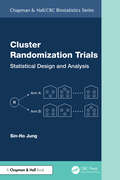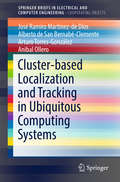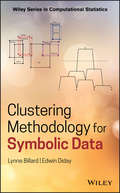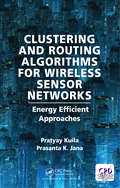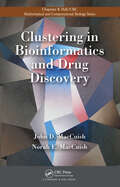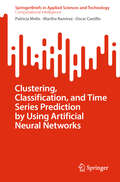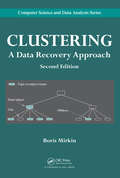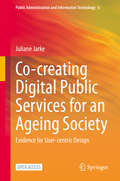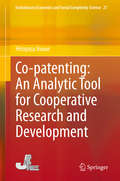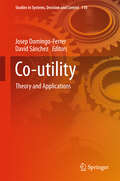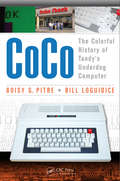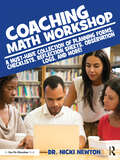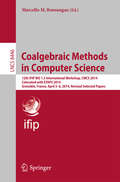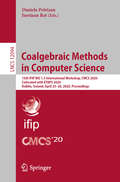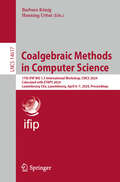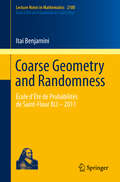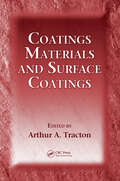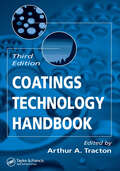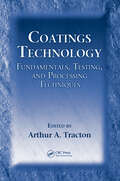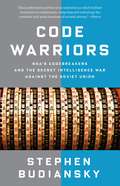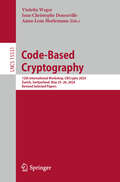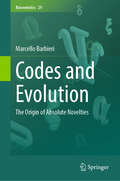- Table View
- List View
Cluster Randomization Trials: Statistical Design and Analysis (Chapman & Hall/CRC Biostatistics Series)
by Sin-Ho JungOftentimes, small groups (called clusters) of individuals (called subunits) are randomized between treatment arms. Typically, clusters are families, classes, communities, surgeons operating patients, and so on. Such trials are called cluster randomization trials (CRTs). The subunits in each cluster share common frailties so that their outcomes tend to be positively correlated. Since clusters are independent, the data in two arms are independent in CRTs. In a clinical trial, multiple sites (such as teeth or ears) from each subject may be randomized between different treatment arms. In this case, the sites (subunits) of each subject (cluster) share common genetic, physiological, or environmental characteristics so that their observations tend to be positively correlated. This kind of trials are called subunit randomization trials (SRTs). In SRTs, dependency exists both within and between treatment arms. Individually randomized group treatment (IRGT) trials are composite of traditional independent subject randomization and CRTs. In an IRGT trial, the control arm is to treat patients individually, whereas the experimental arm is to treat patients using a group training, education, or treatment to increase the treatment effect by close interactions among patients. As a result, the outcome data of the control arm are independent as in traditional trials, but those in the experimental arm are correlated within each group (cluster) as in CRTs. Hence, two arms in IRGT trials have different dependency structures. Unlike standard CRTs, clusters of IRGT trials are usually organized after randomization. But statistically, they have identical statistical issues between the two types of trials, i.e., accounting for the dependency within each cluster. Although this book is entitled Cluster Randomization Trials, it covers all three types of trials (i.e., CRTs, SRTs, and IRGT trials) resulting in clustered data. For outcome variables of binary, continuous, and time-to-event types, we investigate generalized estimating equation type statistical tests and their sample size formulas. Also presented are random number generation algorithms for different types of outcome variables and randomization methods. The methods are discussed in terms of clinical trials, but can be used to design and analyze any types of experiments involving clustered data. This book also discusses statistical methods for various types of biomarker studies, including ROC methods, with clustered data. Key Features: Includes extensive statistical tests and their sample size formulas for various types of clinical trials resulting in clustered data. Handles different variable types of endpoints separately. Discusses algorithms to generate clustered binary and survival data that are useful for simulations. Covers statistical tests and sample size formulas for medical tests with clustered data.
Cluster-based Localization and Tracking in Ubiquitous Computing Systems (SpringerBriefs in Electrical and Computer Engineering)
by Anibal Ollero José Ramiro Martínez-de Dios Alberto de San Bernabé-Clemente Arturo Torres-GonzálezLocalization and tracking are key functionalities in ubiquitous computing systems and techniques. In recent years a very high variety of approaches, sensors and techniques for indoor and GPS-denied environments have been developed. This book briefly summarizes the current state of the art in localization and tracking in ubiquitous computing systems focusing on cluster-based schemes. Additionally, existing techniques for measurement integration, node inclusion/exclusion and cluster head selection are also described in this book.
Clustering Methodology for Symbolic Data (Wiley Series in Computational Statistics)
by Lynne Billard Edwin DidayCovers everything readers need to know about clustering methodology for symbolic data—including new methods and headings—while providing a focus on multi-valued list data, interval data and histogram data This book presents all of the latest developments in the field of clustering methodology for symbolic data—paying special attention to the classification methodology for multi-valued list, interval-valued and histogram-valued data methodology, along with numerous worked examples. The book also offers an expansive discussion of data management techniques showing how to manage the large complex dataset into more manageable datasets ready for analyses. Filled with examples, tables, figures, and case studies, Clustering Methodology for Symbolic Data begins by offering chapters on data management, distance measures, general clustering techniques, partitioning, divisive clustering, and agglomerative and pyramid clustering. Provides new classification methodologies for histogram valued data reaching across many fields in data science Demonstrates how to manage a large complex dataset into manageable datasets ready for analysis Features very large contemporary datasets such as multi-valued list data, interval-valued data, and histogram-valued data Considers classification models by dynamical clustering Features a supporting website hosting relevant data sets Clustering Methodology for Symbolic Data will appeal to practitioners of symbolic data analysis, such as statisticians and economists within the public sectors. It will also be of interest to postgraduate students of, and researchers within, web mining, text mining and bioengineering.
Clustering and Routing Algorithms for Wireless Sensor Networks: Energy Efficiency Approaches
by Pratyay Kuila Prasanta K JanaWireless Sensor Networks have a wide range of applications in different areas. Their main constraint is the limited and irreplaceable power source of the sensor nodes. In many applications, energy conservation of the sensor nodes and their replacement or replenishment due to the hostile nature of the environment is the most challenging issue. Energy efficient clustering and routing are the two main important topics studied extensively for this purpose. This book focuses on the energy efficient clustering and routing with a great emphasis on the evolutionary approaches. It provides a comprehensive and systematic introduction of the fundamentals of WSNs, major issues and effective solutions.
Clustering in Bioinformatics and Drug Discovery (Chapman & Hall/CRC Computational Biology Series)
by John David MacCuish Norah E. MacCuishWith a DVD of color figures, Clustering in Bioinformatics and Drug Discovery provides an expert guide on extracting the most pertinent information from pharmaceutical and biomedical data. It offers a concise overview of common and recent clustering methods used in bioinformatics and drug discovery.Setting the stage for subsequent material, the firs
Clustering, Classification, and Time Series Prediction by Using Artificial Neural Networks (SpringerBriefs in Applied Sciences and Technology)
by Oscar Castillo Patricia Melin Martha RamirezThis book provides a new model for clustering, classification, and time series prediction by using artificial neural networks to computationally simulate the behavior of the cognitive functions of the brain is presented. This model focuses on the study of intelligent hybrid neural systems and their use in time series analysis and decision support systems. Therefore, through the development of eight case studies, multiple time series related to the following problems are analyzed: traffic accidents, air quality and multiple global indicators (energy consumption, birth rate, mortality rate, population growth, inflation, unemployment, sustainable development, and quality of life). The main contribution consists of a Generalized Type-2 fuzzy integration of multiple indicators (time series) using both supervised and unsupervised neural networks and a set of Type-1, Interval Type-2, and Generalized Type-2 fuzzy systems. The obtained results show the advantages of the proposed model of Generalized Type-2 fuzzy integration of multiple time series attributes. This book is intended to be a reference for scientists and engineers interested in applying type-2 fuzzy logic techniques for solving problems in classification and prediction. We consider that this book can also be used to get novel ideas for new lines of research, or to continue the lines of research proposed by the authors of the book.
Clustering: A Data Recovery Approach, Second Edition
by Boris MirkinOften considered more of an art than a science, books on clustering have been dominated by learning through example with techniques chosen almost through trial and error. Even the two most popular, and most related, clustering methods-K-Means for partitioning and Ward's method for hierarchical clustering-have lacked the theoretical underpinning req
Co-creating Digital Public Services for an Ageing Society: Evidence for User-centric Design (Public Administration and Information Technology #6)
by Juliane JarkeThis open access book attends to the co-creation of digital public services for ageing societies. Increasingly public services are provided in digital form; their uptake however remains well below expectations. In particular, amongst older adults the need for public services is high, while at the same time the uptake of digital services is lower than the population average. One of the reasons is that many digital public services (or e-services) do not respond well to the life worlds, use contexts and use practices of its target audiences. This book argues that when older adults are involved in the process of identifying, conceptualising, and designing digital public services, these services become more relevant and meaningful.The book describes and compares three co-creation projects that were conducted in two European cities, Bremen and Zaragoza, as part of a larger EU-funded innovation project. The first part of the book traces the origins of co-creation to three distinct domains, in which co-creation has become an equally important approach with different understandings of what it is and entails: (1) the co-production of public services, (2) the co-design of information systems and (3) the civic use of open data. The second part of the book analyses how decisions about a co-creation project’s governance structure, its scope of action, its choice of methods, its alignment with strategic policies and its embedding in existing public information infrastructures impact on the process and its results. The final part of the book identifies key challenges to co-creation and provides a more general assessment of what co-creation may achieve, where the most promising areas of application may be and where it probably does not match with the contingent requirements of digital public services. Contributing to current discourses on digital citizenship in ageing societies and user-centric design, this book is useful for researchers and practitioners interested in co-creation, public sector innovation, open government, ageing and digital technologies, citizen engagement and civic participation in socio-technical innovation.
Co-patenting: A Network Science Approach (Evolutionary Economics and Social Complexity Science #21)
by Hiroyasu InoueThis is the first book that comprehensively analyses co-patenting in Japan and the U.S., which directly signifies collaborations between firms and inventors, using the methodology of network science. Network science approaches enable us to analyse the structures of co-patenting networks. In addition, generative models in network science estimate the probability of new connections between nodes, which enables us to discuss the temporal development of networks. On the other hand, regression analyses, which are broadly used in the field of economics, may be effective for determining what attributes are important for firms and inventors that are going to be connected, but such techniques cannot consider the complexity of networks. This book compiles a series of studies by the author on geographical location and co-patenting using data that were published in eight academic journal articles. This book gives the reader ideas about how we can utilize patent data to understand how firms and inventors collaborate under the effect of complex networks.
Co-utility: Theory and Applications (Studies in Systems, Decision and Control #110)
by Josep Domingo-Ferrer David SánchezThis book explores the theoretical foundations of co-utility as well as its application to a number of areas, including distributed reputation management, anonymous keyword search, collaborative data anonymization, digital oblivion, peer-to-peer (P2P) content distribution, ridesharing for sustainable mobility, environmental economy, business model design and the collaborative economy. It evolved from presentations at the 1st Co-Utility Workshop, "held in Tarragona, Spain, on March 10-11, 2016. " How can we guarantee that a global society without a common legal framework operates smoothly? If generosity, honesty and helpfulness do not arise spontaneously, one approach would be to design transactions so that helping others remains the best rational option. This is precisely the goal of co-utility, which can be defined in game-theoretic terms as any interaction between peers in which the best option for a player to maximize her or his utility is to make sure the other players also enjoy a fair share of utility (for example, functionality, security or privacy). Therefore, a protocol or mechanism designed using the co-utility principle ensures that helping others is the best rational option, even if players are selfish.
CoCo: The Colorful History of Tandy's Underdog Computer
by Bill Loguidice Boisy G PitreCoCo: The Colorful History of Tandy's Underdog Computer is the first book to document the complete history of the Tandy Color Computer (CoCo), a popular 8-bit PC series from the 1980s that competed against the era's biggest names, including the Apple II, IBM PC, and Commodore 64. The book takes you inside the interesting stories and people behind t
Coach New Generation Practice Tests, Mathematics, [Grade] 4
by Triumph LearningNIMAC-sourced textbook
Coaching Math Workshop
by Nicki NewtonCoaching math workshops? This invaluable resource from beloved guru Dr. Nicki Newton has everything you need to help your teachers and students be successful! Dr. Nicki saves you time and prep work by providing a plethora of tools to help you with each step. She provides an overview of the workshop; getting to know you activities; forms for goal setting, reflections, PD planning, and feedback; calendars; to do lists; data and material logs; lists of things to buy; planning sheets for book studies; and more! With this book's handy checklists and tools, you'll have everything you need to coach math workshop at your fingertips!
Coalgebraic Methods in Computer Science: 12th IFIP WG 1.3 International Workshop, CMCS 2014, Colocated with ETAPS 2014, Grenoble, France, April 5-6, 2014, Revised Selected Papers (Lecture Notes in Computer Science #8446)
by Marcello M. BonsangueThis book constitutes the thoroughly refereed post-proceedings of the 12th International Workshop on Coalgebraic Methods in Computer Science, CMCS 2014, colocated with ETAPS 2014, held in Grenoble, France, in April 2014. The 10 revised full papers were carefully reviewed and selected from 20 submissions. Also included are three invited talks. The papers cover a wide range of topics in the theory, logics and applications of coalgebras.
Coalgebraic Methods in Computer Science: 15th IFIP WG 1.3 International Workshop, CMCS 2020, Colocated with ETAPS 2020, Dublin, Ireland, April 25–26, 2020, Proceedings (Lecture Notes in Computer Science #12094)
by Daniela Petrişan Jurriaan RotThis book constitutes the thoroughly refereed post-conference proceedings of the 15th International Workshop on Coalgebraic Methods in Computer Science, CMCS 2020, colocated with ETAPS 2020, held in Dublin, Ireland, in April 2020. The conference was held as several online events in September and October due to the COVID-19 pandemic. The 9 revised full papers were carefully reviewed and selected from 13 submissions. Also included is one invited talk. The papers cover a wide range of topics in the theory, logics, and applications of coalgebras.
Coalgebraic Methods in Computer Science: 17th IFIP WG 1.3 International Workshop, CMCS 2024, Colocated with ETAPS 2024, Luxembourg City, Luxembourg, April 6–7, 2024, Proceedings (Lecture Notes in Computer Science #14617)
by Barbara König Henning UrbatThis book constitutes the post-conference proceedings of the 17th International Workshop on Coalgebraic Methods in Computer Science, CMCS 2024, colocated with ETAPS 2024, held in Luxembourg in April 2024. The 10 papers included in these proceedings were carefully reviewed and selected from 15 submissions. The papers cover a wide range of topics on theory, logics, and applications of coalgebras.
Coarse Geometry and Randomness: École d’Été de Probabilités de Saint-Flour XLI – 2011 (Lecture Notes in Mathematics #2100)
by Itai BenjaminiThese lecture notes study the interplay between randomness and geometry of graphs. The first part of the notes reviews several basic geometric concepts, before moving on to examine the manifestation of the underlying geometry in the behavior of random processes, mostly percolation and random walk. The study of the geometry of infinite vertex transitive graphs, and of Cayley graphs in particular, is fairly well developed. One goal of these notes is to point to some random metric spaces modeled by graphs that turn out to be somewhat exotic, that is, they admit a combination of properties not encountered in the vertex transitive world. These include percolation clusters on vertex transitive graphs, critical clusters, local and scaling limits of graphs, long range percolation, CCCP graphs obtained by contracting percolation clusters on graphs, and stationary random graphs, including the uniform infinite planar triangulation (UIPT) and the stochastic hyperbolic planar quadrangulation (SHIQ).
Coarse Geometry of Topological Groups (Cambridge Tracts in Mathematics #223)
by Christian RosendalThis book provides a general framework for doing geometric group theory for many non-locally-compact topological transformation groups that arise in mathematical practice, including homeomorphism and diffeomorphism groups of manifolds, isometry groups of separable metric spaces and automorphism groups of countable structures. Using Roe's framework of coarse structures and spaces, the author defines a natural coarse geometric structure on all topological groups. This structure is accessible to investigation, especially in the case of Polish groups, and often has an explicit description, generalising well-known structures in familiar cases including finitely generated discrete groups, compactly generated locally compact groups and Banach spaces. In most cases, the coarse geometric structure is metrisable and may even be refined to a canonical quasimetric structure on the group. The book contains many worked examples and sufficient introductory material to be accessible to beginning graduate students. An appendix outlines several open problems in this young and rich theory.
Coatings Materials and Surface Coatings
by Arthur A. TractonDrawing from the third edition of The Coatings Technology Handbook, this text provides a detailed analysis of the raw materials used in the coatings, adhesives, paints, and inks industries. Coatings Materials and Surface Coatings contains chapters covering the latest polymers, carbon resins, and high-temperature materials used for coatings, adhesiv
Coatings Technology Handbook
by Arthur A. TractonServing as an all-in-one guide to the entire field of coatings technology, this encyclopedic reference covers a diverse range of topics-including basic concepts, coating types, materials, processes, testing and applications-summarizing both the latest developments and standard coatings methods. Take advantage of the insights and experience of over
Coatings Technology: Fundamentals, Testing, and Processing Techniques
by Arthur A. TractonDrawn from the third edition of The Coatings Technology Handbook, this book focuses entirely on testing, experimental design, and strategies for selecting processing techniques in the coatings, adhesives, paints, and inks industries. Coatings Technology: Fundamentals, Testing, and Processing Techniques contains the latest coating and processing met
Code Warriors: NSA's Codebreakers and the Secret Intelligence War Against the Soviet Union
by Stephen BudianskyA sweeping, in-depth history of NSA, whose famous "cult of silence" has left the agency shrouded in mystery for decades The National Security Agency was born out of the legendary codebreaking programs of World War II that cracked the famed Enigma machine and other German and Japanese codes, thereby turning the tide of Allied victory. In the postwar years, as the United States developed a new enemy in the Soviet Union, our intelligence community found itself targeting not soldiers on the battlefield, but suspected spies, foreign leaders, and even American citizens. Throughout the second half of the twentieth century, NSA played a vital, often fraught and controversial role in the major events of the Cold War, from the Korean War to the Cuban Missile Crisis to Vietnam and beyond. In Code Warriors, Stephen Budiansky--a longtime expert in cryptology--tells the fascinating story of how NSA came to be, from its roots in World War II through the fall of the Berlin Wall. Along the way, he guides us through the fascinating challenges faced by cryptanalysts, and how they broke some of the most complicated codes of the twentieth century. With access to new documents, Budiansky shows where the agency succeeded and failed during the Cold War, but his account also offers crucial perspective for assessing NSA today in the wake of the Edward Snowden revelations. Budiansky shows how NSA's obsession with recording every bit of data and decoding every signal is far from a new development; throughout its history the depth and breadth of the agency's reach has resulted in both remarkable successes and destructive failures. Featuring a series of appendixes that explain the technical details of Soviet codes and how they were broken, this is a rich and riveting history of the underbelly of the Cold War, and an essential and timely read for all who seek to understand the origins of the modern NSA.From the Hardcover edition.
Code-Based Cryptography: 12th International Workshop, CBCrypto 2024, Zurich, Switzerland, May 25–26, 2024, Revised Selected Papers (Lecture Notes in Computer Science #15531)
by Jean-Christophe Deneuville Violetta Weger Anna-Lena HorlemannThis book constitutes the refereed proceedings of the 12th International Conference on Code-Based Cryptography, CBCrypto 2024, held in Zurich, Switzerland, during May 25–26, 2024. The 5 full papers presented in this book were carefully reviewed and selected from 41 submissions. The conference offers a wide range of many important aspects of code-based cryptography such as cryptanalysis of existing schemes, the proposal of new cryptographic systems and protocols as well as improved decoding algorithms.
Code-Switching as a Pedagogical Tool in Bilingual Classrooms: Insights from a Secondary STEM Classroom in Zimbabwe (Routledge Research in Language Education)
by Miriam ChitigaPresenting a mixed methods study conducted in a bilingual mathematics classroom in Zimbabwe, this text reveals the semantic pedagogical functions and linguistic forms of code-switching during STEM instruction. Code-Switching as a Pedagogical Tool in Bilingual Classrooms offers a detailed analysis of code-switching in the context of educational linguistics, and reveals ten major pedagogical techniques which illustrate how teachers use code-switches to engage students and provide guidance, clarification, discipline, and recaps during individual and whole-class interactions. Chapters highlight that code-switching can be used in a targeted manner to harness the cognitive potential of bilingual speakers and enhance instruction. Ultimately, the text identifies implications for teacher education, language policy, and educational leadership more broadly, and demonstrates intersections with key areas including functional, critical, and cultural literacy. This text will benefit researchers, academics, and educators with an interest in bilingualism, applied linguistics, and secondary education more broadly. Those specifically interested in multicultural education, sociolinguistics and educational policy will also benefit from this book.
Codes and Evolution: The Origin of Absolute Novelties (Biosemiotics #29)
by Marcello BarbieriThis text builds upon the over 1500 papers published in peer-reviewed journals revealing that there are more than 200 biological codes in living systems. The author claims this experimental fact is bound to change biology forever. This book shows how this very discovery reveals that coding is a new mechanism of life, just as the discovery of electromagnetism revealed the existence of a new physical force in the universe. The existence of many biological codes, furthermore, Barbieri argues, is one of those experimental facts that have extraordinary theoretical consequences. It implies that coding is not only a mechanism that constantly operates in all living systems, but also a mechanism of evolution, more precisely a mechanism that gave origin to the absolute novelties of the history of life. This amounts to saying that evolution took place by two distinct mechanisms, by natural selection and by natural conventions, two mechanisms that are fundamentally different because natural selection is the result of copying and deals with information whereas natural conventions are the result of coding and deal with meaning. This volume appeals to students and researchers working in the fields of semiotics, philosophy, biology and mathematics.
